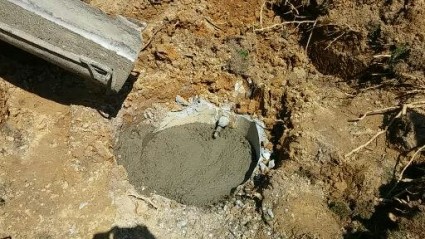 How can I protect the quality of my well water?
How can I protect the quality of my well water?
As a general rule, avoid putting anything on the ground which would be harmful for you to drink. This means being careful with motor oil, antifreeze, gasoline and heating oil. It also means using lawn chemicals, fertilizers, pesticides, deicing chemicals, paints and other like substances carefully. Don’t allow refuse to accumulate anywhere on your property. Remove underground storage tanks and abandon old wells. Protect the top of your well casing from damage and keep it closed. Check the casing periodically for
any signs of damage or obvious cracks. If you have a septic system see that it is cleaned regularly and kept in good repair.
How do I get my water tested?
You will need to go to a private laboratory to get your water tested. The Health Department staff can advise you of what to test for and also provide you with a list of reputable labs. When taking a sample for analysis be sure to follow the lab’s instructions carefully. At the very least the sample should be collected in a clean and sanitary container from a similarly sanitized source.
Can I have all the water I want?
It must be remembered that groundwater is a limited resource and should not be wasted. However, if you get a good well drilled there should be enough water available for your domestic use. The eastern portion of our county is part of a Groundwater Management Area administered by the Virginia Department of Environmental Quality. Anyone desiring to withdraw more than 300,000 gallons per month must obtain a permit before doing so.
 What should I do with an old well on my property?
What should I do with an old well on my property?
First be sure there is a cover on the well and that it is well secured. If you wish to use the well, a well contractor can inspect the well to determine if it can be returned to service. If you wish to abandon the well, a permit from Henrico County Health Department is required. To begin the well abandonment permit process, please contact us at 804-501-4530.
Should I have my well water treated?
There are a number of reputable companies who provide good water treatment services.However, it is best to have your water tested by a lab not affiliated with the water treatment company and seek the advice of the Health Department staff before contracting with anyone for this service. Call (804) 501-4530 for assistance.
Where does well water come from?
It is important to realize that precipitation is the source of drinking water withdrawn from the ground. Water wells are drilled into the ground to a depth at which water can be withdrawn from areas within the soil or bedrock where good water is found in sufficient quantity. These areas or layers are known as “aquifers.” They differ from other layers or areas in the earth because they have more interconnected open spaces through which water will flow. Water flows through and accumulates in these small pore spaces and not in underground lakes or rivers. Water falling on the ground will be drawn into aquifers in one of two ways.
If the aquifer is exposed at the land surface, water will flow into it either from a body of surface water or from precipitation seeping downward through the overlying layers in the earth. If the aquifer is not exposed on the surface or beneath a body of water, that portion of precipitation which does find its way to the ocean or is not evaporated from the earth will gradually seep downward to the aquifer through the overlying layers in the earth. Contaminants on the surface of the earth, in these overlying layers or in surface water, can be carried into the aquifer along with the water that is recharging the aquifer. For this reason it is necessary to protect areas through which the recharging water moves in order to maintain the quality of the water withdrawn from a well.
What aquifiers are in our county?
Groundwater in Henrico County is found in two different types of geologic settings: consolidated rock and unconsolidated sediments. The aquifer in the western portion of the County consists of the fractures and joints within the granite bedrock and the decomposed granite above the bedrock. This aquifer is particularly vulnerable to contamination from any pollutants introduced at the land’s surface. Aquifers in the eastern portion of the County are made up of unconsolidated sand, gravel, silt and clay. One of these aquifers, often called the “water table aquifer,” is located near the surface of the earth. There are still many older private wells withdrawing water from this aquifer, but fewer new wells are using it. This is fortunate, because these wells are especially vulnerable to contamination from pollutants on the land around them. Beneath this surface aquifer are thick layers of clay through which the water moves very slowly.
Beneath the layers of clay are other aquifers known as “confined” or “artesian” aquifers. Most of the public water supply wells in the eastern portion of Henrico County withdraw water from these aquifers. The water recharging confined aquifers enters by two different routes. A portion of it leaks very slowly through the overlying clay layers. The rest is believed to enter the aquifer at the points near the river where the aquifer is exposed at the land surface.
What types of wells are there in our county?
There are all types of wells in our county. Some very old wells are known as “dug” wells because they were constructed by digging a hole to water and lining that hole with brick or other building material. These wells are extremely susceptible to contamination and should be taken out of service.
Other shallow wells are known as “bored” wells because they were constructed by boring a hole, often three feet in diameter, to bedrock in the western part of the county or to the green marine clay in the eastern part of the county. In the past these wells were sufficient for a single residence but the modern homeowner would be wise to avoid them. Since the water withdrawn from them is closer to the surface it is closer to sources of contamination, even if the well casing is intact. Moreover, amount of water available from these wells is more directly affected by droughts and so less water is available at times when more water is needed. This is especially true in subdivisions with smaller lots where a number of wells may be pumping at the same time. Finally, many people who have shallow wells in the eastern part of the county have found that the water is too acidic.
The other type of well is known as a “drilled” well. Drilled wells are normally less than a foot in diameter and are constructed by drilling a hole a few hundred feet in the ground to a deeper source of water. In the eastern portion of the county the well is drilled into a confined aquifer and screens are placed in the well opposite the water zones. A “gravel” pack of coarse sand is usually placed around the screened area to prevent sand from the aquifer from entering the well. In the western portion of the county the well is drilled into the bedrock, usually granite, until a fracture zone with a suitable amount of water, ideally more than 5 gallons per minute, is encountered. Often it is not necessary to screen these areas so the well can be cased to a point just below the top of the bedrock. In both types of drilled well grout is injected to a point where the well is in impermeable material so that the well is protected from surface contamination.
How do I get a well drilled?
The first thing you should do is get in contact with the Henrico Health Department at 804-501-4530. Health Department staff can advise you of any restrictions governing the location of the well. Once you have discussed the well with the Health Department Staff you will need to get in touch with several well drillers to get estimates. Be sure to select a driller who will provide you and all appropriate state agencies with the records for your well. These can prove useful in later years. While the well is being drilled it pays to keep in contact with the Health Department so that they can help ensure that a sanitary well is being constructed.
What should my well look like?
Bored wells in the Coastal Plain and the Piedmont are similar in appearance. Using a large auger, the Driller bores to the marine clay in the Coastal Plain or to solid bedrock in the Piedmont. Sections of concrete pipe, usually 36 inches in diameter are lowered into the hole to support the sides. The bottom of this piping is left open so that water flowing through the coarse sand and gravel can enter the well. The space between the outside of the casing and the earth is sealed with a cement grout and the top of the well is capped in order to protect the inside of the well from outside contamination.
A drilled well in the Piedmont is almost as simple. In constructing one of these wells, the Driller first drills a hole down to bedrock. He then continues this hole using a smaller diameter bit into the bedrock until he encounters an area within the rock where sufficient water is available. Often the hole will be extended beyond this area in order to create some capacity for storage. It is often not necessary to support the walls of this type of well within the bedrock. A steel casing is placed in the well to a depth just inside the bedrock and grouted in place to keep out surface contamination.
A drilled well in the Coastal Plain is more complicated since it is drilled into sediments which may collapse into the hole. As the hole is drilled an expanding clay and water mixture is circulated to keep the hole open. The well is drilled through the surface sand and gravel and the underlying marine clay to a sand and gravel layer where sufficient water is available. The finished well consists mostly of casing with well screens extending through the sand and gravel layers. Screened portions of wells have taken different forms down through the years but currently stainless steel continuous wire wound screens are the rule. Usually the area of the hole outside the screen has a “gravel pack” placed around it consisting of quartz sand. The sizes of the gravel pack and the screens are selected so as to keep silt and sand out of the well while letting the greatest amount of water into the well. There are several books which set forth rules for selecting a size for the screens but an experienced driller may have his own proven ideas. The important thing is to make sure that these sizes are not chosen arbitrarily but rather are based on a size analysis of the actual material coming out of the well during the drilling process. For several tens of feet below the surface of the earth the outside of the casing is grouted to protect the quality of the water coming into the well.


